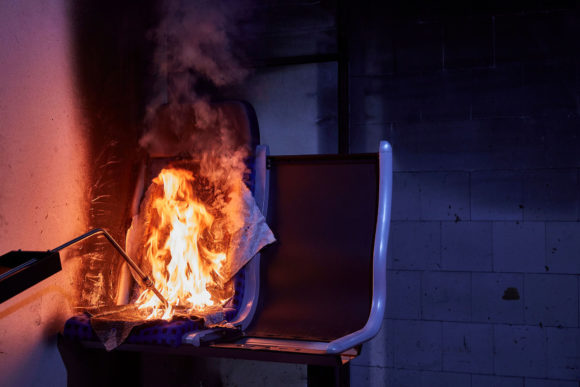Heat release rate
What is meant by heat release rate?
The heat release rate indicates how much heat is released during combustion. It usually refers to the burnt mass or burning area and is expressed in kilowatts per square metre or megajoules per kilogram. The heat release rate is the time course of the heat release. A high heat release rate contributes to rapid heating of the surrounding area and ignition of nearby objects. It thus promotes the development of a small, localised fire into a large fire. Therefore, the heat release rate is one of the most important fire risks that must be limited.

Range of services of our fire laboratory
In our fire laboratory, we determine the heat release rate under realistic conditions. To do this, the material is exposed to an irradiance in room air that simulates a developing fire near the material to be tested with a strength of e.g. 50 kW/m², comparable to a burning wastepaper bin at a distance of one metre. The material ignites and the fire gases are extracted and analysed. The heat release rate during combustion is calculated from the oxygen consumption, this is called oxygen consumption calorimetry. Interestingly, regardless of the type of material burned, approximately 13.1 MJ of heat is released per kilogram of oxygen burned.
Passenger seats for rail vehicles must resist arson. To do this, they are slit open and exposed to a flame with a power of up to 15 kW by a burner. In this test, too, the rate of heat release is measured using oxygen consumption calorimetry and is an essential criterion for the seat's performance.
In the bomb calorimeter, the heat release - not the rate here - is determined under conditions far removed from reality. Combustion takes place in a closed pressure vessel ("bomb") in an atmosphere of pure oxygen at 30 bar. Under these conditions, the test material burns completely. The heat released is measured by the temperature increase and is also called calorific value. With regard to the fire risk of the material, this calorific value is a worst case, because most materials do not burn completely in a normal atmosphere and therefore also release less heat than in the artificial bomb calorimeter.

What are the advantages of heat release rate tests?
Heat release rate tests allow you to assess the ability of your materials to prevent the development of a fire or delay it sufficiently to allow people to escape to safety. This requirement is placed on materials which are used in rail vehicles and ships. Use our heat release rate tests and obtain the necessary proof that your material complies with the required heat release rate limits with our test reports.
The heat release data is also used as input parameters in the numerical simulation of fires, from which the fire risk is derived.
Are you in need of heat release rate tests?
We would gladly support you. Contact us for testing.